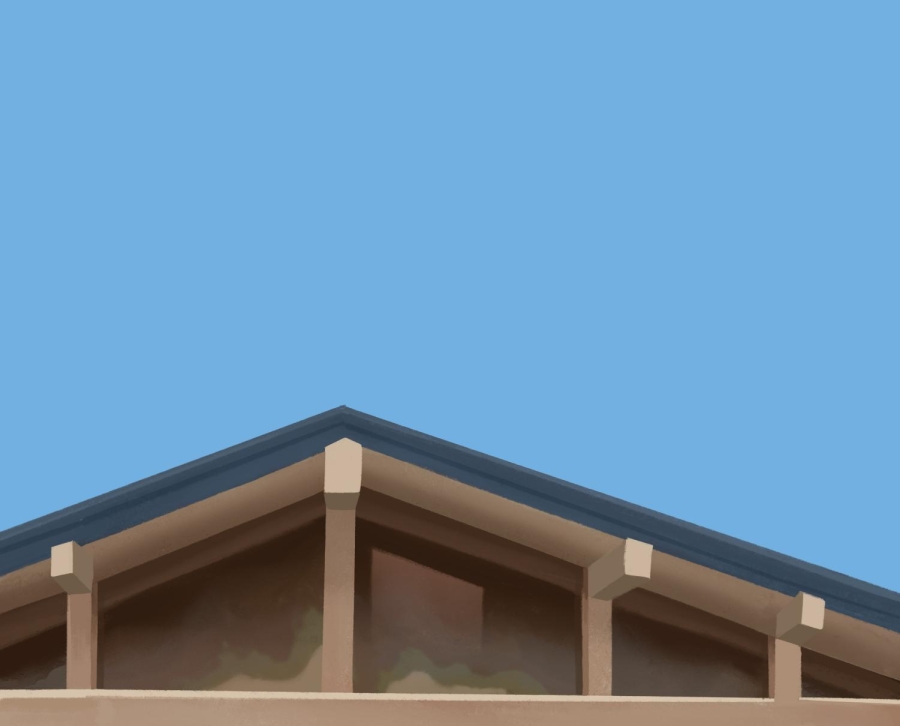Opinion: Architecture for all?: Eichler homes are no longer affordable
How do affordable family homes become collector’s items? Against all odds, Palo Alto’s thousands of Eichler homes have outpaced inflation to do just that — despite being designed to be low-cost.
Growing up in an Eichler in Palo Alto’s Green Gables neighborhood, I learned recently that my neighborhood is on the National Register of Historic Places because of its distinctive mid-century modern design.
For a long time, Eichlers were some of the cheapest properties available in this area — which, decades prior, is exactly what their creator intended. There is a delicate balance between preserving iconic architecture and allowing for population growth in a community, and it’s crucial that this community take a firm stance: allowing for more affordable housing is more important than “ruining” Eichler subdivisions.
Building out the ’burbs
In the late 1940s, real estate developer Joseph Eichler set out to fill the suburbs with homes that had luxurious outdoor spaces, airy atriums and floor-to-ceiling windows at an unbeatable price. Inspired by modern architect Frank Lloyd Wright, he built subdivisions of cutting edge mid-century modern homes. Palo Alto has more than any other city — over 2,000, according to Atria Real Estate. Eichler’s strategy was unique in that he had a non-discrimination policy, meaning that he sold to anyone, without regard to race or ethnicity.
In the early 1950s, the sale price of a three-bedroom, one-and-a-half bathroom Eichler home in Palo Alto was about $15,000 according to Palo Alto Online, a price low enough to grant a middle-class family their own slice of the American dream. Eichler’s ads proudly proclaimed that they were “the home they all promised but only Eichler Homes is building.”
But, recently, the Eichler dream has begun to slip away.
Intensifying interest
Eichlers in Palo Alto now sell for a higher price per square foot than other similarly sized homes in the area, according to CA Modern magazine. Despite their relatively old age and small size, an architectural style once praised for its affordability now serves as a symbol of the unattainability of Bay Area home buying, which is ironic considering the original purpose that they were created to serve.
Kevin Swartz of Atria Real Estate, which specializes in Eichler homes, said that the demand for Eichler homes has been growing due to falling numbers of original homes.
“There were right around 2,700 of them [Eichlers] in Palo Alto at one time,” Swartz said. “But I think today there’s around 2,200.”
As their popularity increases, Swartz said that he has noticed an uptick in Eichler home prices.
“There are buyers who specifically want to buy Eichlers,” Swartz said. “And so for that factor alone, there’s always going to be a premium that they have to pay.”
Almost all of Palo Alto’s original Eichlers are single-story, according to Palo Alto Online, and are surrounded by similar homes of similar sizes. In 2015, Palo Alto enacted a ban on two-story homes in the Los Arboles Eichler subdivision. The effort was met with praise from residents — their historic neighborhood could be saved from the multi-story McMansions that would inevitably replace historic homes. However, many opposed the ban because it prevented these neighborhoods from being able to accommodate any further residents, exacerbating the already pressing housing crisis.
Aftermath of advancement
Would Eichler, who was so concerned about housing equity and affordability, be happy with what has become of his homes?
Realistically, nothing like the Eichler boom will ever happen again in the Bay Area. There is simply not enough undeveloped land for building thousands of affordable homes, so single family homes can’t be the future of Palo Alto. If we want to promote the construction of affordable housing, there’s no way that we can keep prioritizing the conservation of historic homes like Eichlers. While Eichler’s designs were revolutionary at the time, as decades have passed, the fantasy of affordable single-family homes has gone with them. In order to prepare Palo Alto for the future, we must start allowing more affordable housing to take the places of Eichlers.





